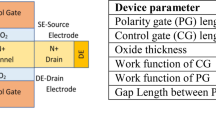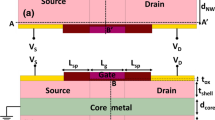Abstract
Herein we introduce and investigate a new architectural design strategy for planar single gate field effect transistors (SG-FETs) that delivers advantages from all fronts of design, fabrication and performance perspectives. The amalgamation of schottky buried metal layer (BML) and charge plasma (CP) mechanism of doping in planar single gate architecture yields a novel type of FET called as CP-BML FET. Owing to the schottky BML induced depletion region created on the bottom side of device layer reduces effective device layer thickness (TSi) suppressing short channel effects (SCEs) including drain induced barrier lowering (DIBL) and threshold voltage roll-off. The proposed FET has been analyzed for DC and RF performance figure of merits (FOMs) and compared to counter part state of the art technologies with reference to ITRS performance projections. The proposed FET is also investigated the performance FOMs on for criticality of physical parameters including gate length (Lg), device layer thickness (TSi), BML workfunction (ϕBML). The ION and IOFF for proposed device at Lg = 20nm read at 730μ A/μ m and 7 × 10− 2 pA/μ m respectively. RF performance analysis reveal transition frequency (ft) of 390 GHz with SS \(\simeq \ \text {75mV/dec}\) coherent with ITRS performance projections. It is found that ultra scaled (7 nm) proposed device exhibits intrinsic delay τ of 0.6 ps which is superior to ITRS projections of 1.71 ps at 28 nm technology node. The proposed device yields Pdyn of 0.248 fJ/μ m at Lg= 7nm implicating it to be potential candidate for low power with high performance application requirements.
Similar content being viewed by others
Data Availability
There is no linked research data for this submission.
References
Sheu B, Olstein K (2015) . IEEE Solid-State Circuits Magazine 7(2):67. https://doi.org/10.1109/MSSC.2015.2418472
Ávila Herrera F, Hirano Y, Miura-Mattausch M, Iizuka T, Kikuchihara H, Mattausch HJ, Ito A (2019) . IEEE Trans Electron Devices 66(9):3726. https://doi.org/10.1109/TED.2019.2931749
Jaiswal N, Kranti A (2018) . IEEE Trans Electron Devices 65(9):3669. https://doi.org/10.1109/TED.2018.2856839
Angelov GV, Nikolov DN, Hristov MH (2019) . J Electr Comput Eng 2019:4792461. https://doi.org/10.1155/2019/4792461
Gargini P (2017) .. In: 2017 Fifth Berkeley symposium on energy efficient electronic systems steep transistors workshop (E3S). https://doi.org/10.1109/E3S.2017.8246153, pp 1–62
Lu W-Y, Taur Y (2006) . IEEE Trans Electron Devices 53 (5):1137. https://doi.org/10.1109/TED.2006.871879
Pacheco-Sanchez A, Loroch D, Mothes S, Schröter M, Claus M (2016) .. In: 2016 International conference on simulation of semiconductor processes and devices (SISPAD). https://doi.org/10.1109/SISPAD.2016.7605201, pp 277–280
Sahay S, Kumar MJ (2017) . IEEE Trans Electron Devices 64(6):2604. https://doi.org/10.1109/TED.2017.2688134
Xie Q, Wang Z, Taur Y (2017) . IEEE Trans Electron Devices 64(8):3511. https://doi.org/10.1109/TED.2017.2716969
Shafi N, Sahu C, Periasamy C (2019) . IEEE Electron Device Letters 40(6):997. https://doi.org/10.1109/LED.2019.2911334
Colinge J, Lee C, Afzalian A, Akhavan ND, Yan R, Ferain I, Razavi P, O’Neill B, Blake A, White M, Kelleher AM, McCarthy B, Murphy R (2010) . Nature Nanotechnology 5 (3):225. https://doi.org/10.1038/nnano.2010.15
Colinge J, Kranti A, Yan R, Lee C, Ferain I, Yu R, Dehdashti Akhavan N, Razavi P (2011) . Solid-State Electronics 65-66:33. Selected Papers from the ESSDERC 2010 Conference. https://doi.org/10.1016/j.sse.2011.06.004
Sahu C, Singh J (2014) . IEEE Electron Device Letters 35(3):411. https://doi.org/10.1109/LED.2013.2297451
Hueting RJE, Rajasekharan B, Salm C, Schmitz J (2008) . IEEE Electron Device Letters 29(12):1367. https://doi.org/10.1109/LED.2008.2006864
Lahgere A, Kumar MJ (2017) . IEEE Trans Electron Devices 64(1):3. https://doi.org/10.1109/TED.2016.2622741
Gupta PS, Kanungo S, Rahaman H, Dasgupta PS (2012) .. In: 2012 International conference on computing, electronics and electrical technologies (ICCEET). https://doi.org/10.1109/ICCEET.2012.6203784, pp 761–765
Gundapaneni S, Ganguly S, Kottantharayil A (2011) . IEEE Electron Device Letters 32 (3):261. https://doi.org/10.1109/LED.2010.2099204
Shafi N, Sahu C, Periasamy C (2020) . IEEE Sensors J 20(9):4749. https://doi.org/10.1109/JSEN.2020.2964625
Shafi N, Sahu C, Periasamy C (2018) . Superlattices Microstruct 120:75. https://doi.org/10.1016/j.spmi.2018.05.006
Saraswat KC, Brors DL, Fair JA, Monnig KA, Beyers R (1983) . IEEE Trans Electron Devices 30(11):1497. https://doi.org/10.1109/T-ED.1983.21328
Chen C, Liu W, Ma X, Shen Q, Song Z, Lin C (2009) . Thin Solid Films 517(8):2724. https://doi.org/10.1016/j.tsf.2008.10.043. http://www.sciencedirect.com/science/article/pii/S0040609008012704
Zhu S, Huang Y, Ru G, Qu X, Li B (1999) . Journal of The Electrochemical Society 146(7):2712. https://doi.org/10.1149/1.1391997
Alam K, Lake R (2012) . IEEE Trans Electron Devices 59:3250
Ehteshamuddin M, Loan SA, Rafat M (2018) . IEEE Electron Device Letters 39(6):799. https://doi.org/10.1109/LED.2018.2829915
Avci UE, Morris DH, Young IA (2015) . IEEE J Electron Devices Soc 3(3):88. https://doi.org/10.1109/JEDS.2015.2390591
Lee K, Lee J, Kim S, Lee R, Kim S, Kim M, Lee J, Kim S, Park B (2020) . IEEE Trans Nanotechnol 19:168. https://doi.org/10.1109/TNANO.2020.2972605
Chen W, Zhang J, He Q, Zhou H, Huang X, Ren Z, Su K, Mao W, Xue J, Zheng X, Zhang J, Hao Y (2019) . IEEE Trans Electron Devices 66(11):4673. https://doi.org/10.1109/TED.2019.2940504
Kale S, Kondekar PN (2017) . IEEE Trans Electron Devices 64(11):4400. https://doi.org/10.1109/TED.2017.2754881
Tripathy MR, Singh AK, Samad A, Singh PK, Baral K, Jit S (2020) . Semiconductor Science and Technology 35(10):105014. https://doi.org/10.1088/1361-6641/aba418
Yu E, Lee WJ, Jung J, Cho S (2018) IEEE Trans Electron Devices: 1. https://doi.org/10.1109/TED.2018.2808764
Sahay S, Kumar MJ (2016) . IEEE Trans Electron Devices 63(10):4138. https://doi.org/10.1109/TED.2016.2601239
Shafi N, Bhat AM, Parmar JS, Sahu C, Periasamy C (2021) IEEE Trans Nanotechnology: 1–1. https://doi.org/10.1109/TNANO.2021.3089717
Acknowledgments
The authors would like to thank head of the department, Department of Electronics and Communication Engineering, Malaviya National Institute of Technology for providing necessary support for carrying out the simulation work.
Funding
No funding was received for this work.
Author information
Authors and Affiliations
Contributions
The main conception of this work is brainchild of N. Shafi (Author 1). A. M. Bhat, J. S. Parmar and A. Powral provided the necessary support regarding simulation and data interpretation. C. Sahu and C. Periasamy supervised the work and made important discussions and modifications to the final manuscript.
Corresponding author
Ethics declarations
Ethics approval
All procedures performed in studies involving human participants were in accordance with the ethical standards of the institutional and/or national research committee and with the 1964 Helsinki declaration and its later amendments or comparable ethical standards.
Informed Consent
Not applicable.
Competing interests
The authors declare for no competing interest.
Additional information
Publisher’s Note
Springer Nature remains neutral with regard to jurisdictional claims in published maps and institutional affiliations.
Rights and permissions
About this article
Cite this article
Shafi, N., Bhat, A.M., Parmaar, J.S. et al. Virtually Doped Schottky Buried Metal Layer Planar Junctionless FET for SCE Suppression at sub-28nm Technology Nodes. Silicon 14, 4619–4631 (2022). https://doi.org/10.1007/s12633-021-01242-w
Received:
Accepted:
Published:
Issue Date:
DOI: https://doi.org/10.1007/s12633-021-01242-w




